Early in the morning of 2 August 1964, the United States destroyer USS Maddox was conducting electronic surveillance of North Vietnamese military communications in the Gulf of Tonkin, off the coast of North Vietnam. The United States and North Vietnam were not yet at war, but something happened that morning – and may or may not have happened two days later – that led to direct U.S. involvement in the Vietnam War.
What is clear about August 2 is that the Maddox engaged in a brief battle with three North Vietnamese patrol boats.
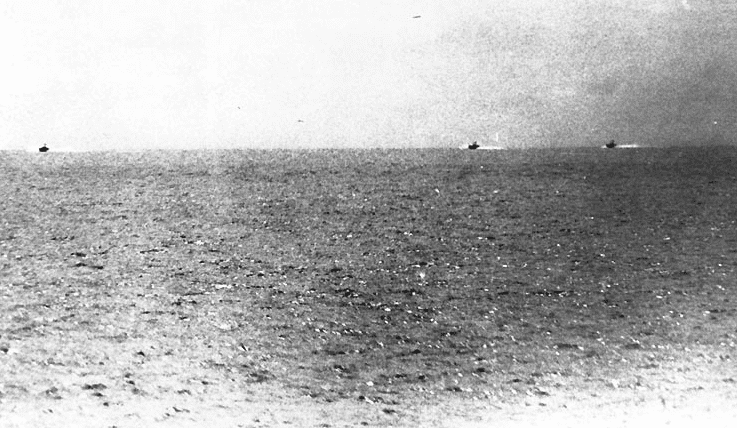
There may have been, but most likely were not, any enemy vessels involved in the second “battle” the Maddox engaged in, on August 4, when it probably was shooting in response to faulty radar and sonar readings. Together, the two engagements are known as the “Gulf of Tonkin Incident,” and President Lyndon B. Johnson used them to convince Congress to authorize military action against North Vietnam, which it did by passing the Gulf of Tonkin Resolution on 7 August 1964.
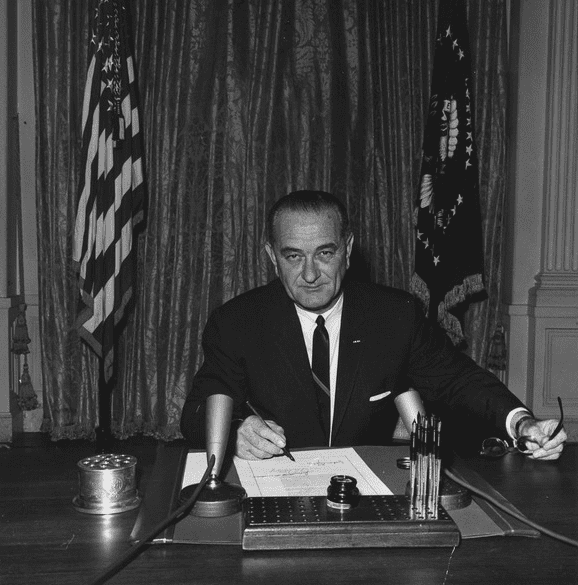
The Maddox had been in the Gulf of Tonkin collecting information since July 31, and the North Vietnamese had been tracking its movements with radar. Passing information to the South Vietnamese army was part of the military and financial assistance the U.S. was giving South Vietnam in its struggle against the North, as well as steadily increasing the number of American military advisers (from 600 in 1961 to 16,000 in 1963).
The Maddox was under strict orders to remain in international waters throughout its Gulf of Tonkin mission, and it was 28 miles off North Vietnam’s coast when the August 2 sea battle occurred.
The Maddox reported that three patrol boats (later identified by Secretary of State Dean Rusk as North Vietnamese) opened fire with torpedoes and machine guns. In response, the Maddox returned fire with its 5-inch and 3-inch guns, and radioed for help from the nearby carrier Ticonderoga – which sent four jets to its assistance. The destroyer and the jets damaged all three enemy vessels and nearly destroyed one, receiving negligible damage in return. The North Vietnamese suffered 10 casualties, including 4 dead. There were no American casualties.
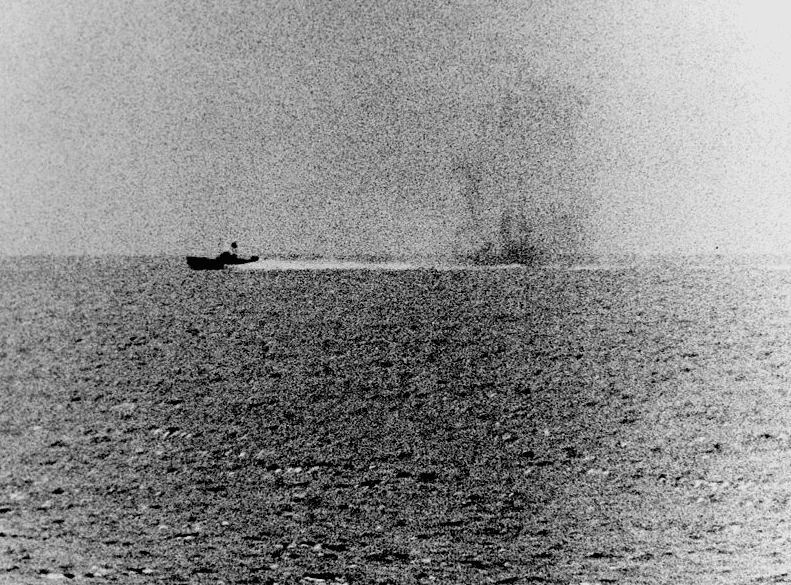
All the American reports emphasized that the Maddox was in international waters and the North Vietnamese fired first – and their action was labeled an “unprovoked attack.”
Historians have confirmed the Maddox was in international waters at the time of the attack, but it turns out the Americans actually fired first, the Maddox hurling three shells to warn the patrol boats to keep their distance – a warning they ignored, choosing to fire back instead. While there almost certainly were not any North Vietnamese boats involved in the August 4 “battle,” there is no disputing that American and North Vietnamese forces clashed on August 2.
There is also no disputing that the two incidents led directly to America’s involvement in the Vietnam War – a conflict in which the U.S. suffered more than 58,000 dead, over 1,700 missing, and more than 303,000 wounded, while ultimately failing to stop the Communist North from prevailing over the South.
The following four newspaper articles broke the news to their readers about the August 2 Gulf of Tonkin incident. The first is a news account of the sea battle. The next three show responses to the incident: the first one political; the next two personal, giving the reaction from Navy wives and the captain’s father.
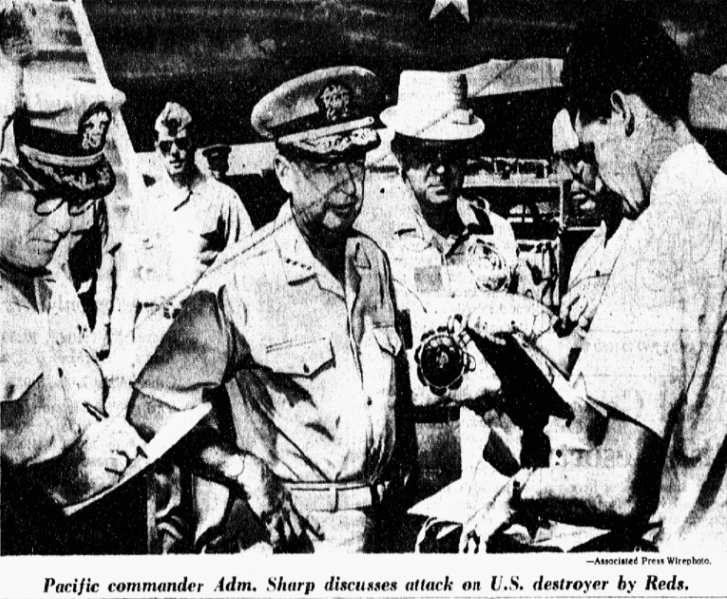
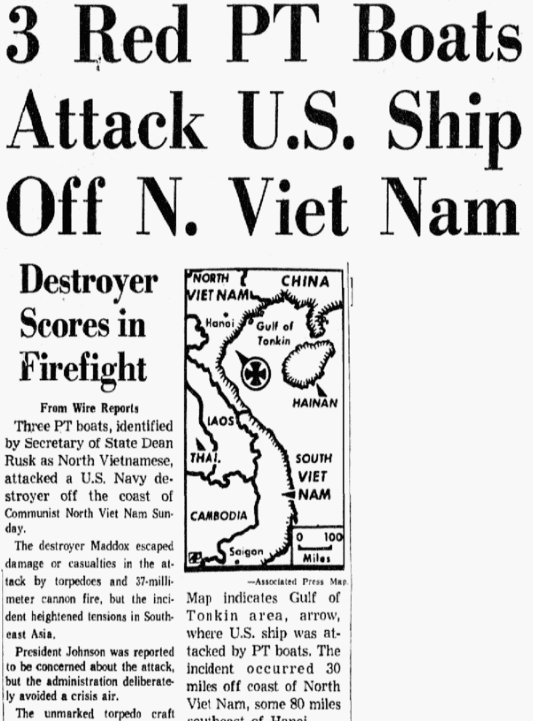
Here is a transcription of this article:
3 Red PT Boats Attack U.S. Ship off N. Viet Nam
Destroyer Scores in Firefight
From Wire Reports
Three PT boats, identified by Secretary of State Dean Rusk as North Vietnamese, attacked a U.S. Navy destroyer off the coast of Communist North Viet Nam Sunday.
The destroyer Maddox escaped damage or casualties in the attack by torpedoes and 37-millimeter cannon fire, but the incident heightened tensions in Southeast Asia.
President Johnson was reported to be concerned about the attack, but the administration deliberately avoided a crisis air.
The unmarked torpedo craft had not been officially identified as North Vietnamese until Rusk did so in New York City when questioned by a reporter.
Counterfire by the Maddox’s guns plus rockets and cannon fire from planes of the carrier Ticonderoga severely damaged one of the attacking PT boats. The two others were reported hard hit.
The severely damaged PT boat was stopped in the water, but there was no indication whether or not the destroyer intended to take her in tow.
“The other side got a sting out of this,” Rusk said. “If they do it again, they’ll get another sting.”
He named “the other side” as the North Vietnamese.
Rusk was interviewed as he entered a midtown hotel for a reception prior to a dinner address to the American Field Service.
The commander of U.S. forces in the Pacific, Adm. Ulysses Grant Sharp Jr., described the action of the PT boats as “an unprovoked attack” reflecting a possible change in the Southeast Asian situation.
In Honolulu, Sharp declared, “If they are so bold as to shoot at us, it is a change.”
In Washington, authorities said the incident occurred in international waters. And Rusk said the United States is “going to use and insist upon using international waters.”
State Department officials said that whether a formal protest to North Viet Nam over the attack will be made by the United States is under study.
There was a possibility that U.S. diplomats might decide not to go through the note-writing routine.
As one put it, the shots fired back when the Maddox was attacked may well speak louder to the Communists than words.
With the PT boat attack, the focus of violence in Southeast Asia shifted northward from South Viet Nam as the sea and other air incidents built up tension in that troubled area of the world.
Hanoi had nothing at all to say about the sea incident hours after it had occurred.
According to the Navy, the attack was launched when the lead patrol boat fired three torpedoes at the Maddox, followed by a fusillade of 37-millimeter shells, all of which missed.
The Maddox opened fire on the boats with her 5-inch guns, meanwhile calling for fighter cover from the Ticonderoga steaming in the vicinity.
Four Navy F8 jet fighters strafed the vessels. One of the boats was stopped in the water, and the other two limped away, “damaged,” the announcement said.
The attack occurred about 30 miles off the coast of North Viet Nam, some 80 miles southeast of Hanoi.
It occurred at 4:08 a.m., the announcement said.
The Maddox is a World War II destroyer which normally carries a crew of 260 men and 14 officers. She is 376 feet long, 40 feet wide and carries armament of six 5-inch guns and six 3-inch guns, a Navy spokesman said.

Here is a transcription of this article:
GOP Claims Ship Attack as ‘Proof’
WASHINGTON (AP) – Republicans pointed to Sunday’s attack on a U.S. destroyer off North Viet Nam as support for their assertions that the administration isn’t handling things well in that troubled part of the world.
Sen. Everett M. Dirksen of Illinois, the Republican Senate leader and a frequent critic of U.S. policy in South Viet Nam, said the futile PT boat attack on the destroyer Maddox calls for “a new hard look” at the U.S. position in that area.
Both Republicans and Democrats applauded the Navy’s prompt and apparently effective return fire against the unidentified PT boats.
No Comment
A White House spokesman said President Johnson was advised promptly of the early-morning attack but there would be no comment at present. Nor was there any indication of whether or when a protest would be lodged against the apparent violation of the freedom of the high seas.
Johnson summoned some top advisers to the White House, presumably to discuss the incident and its effect on U.S. policy. Among those unofficially reported attending were Secretary of State Dean Rusk, Secretary of Defense Robert S. McNamara, Undersecretary of State George W. Ball, Asst. Secretary of Defense Cyrus R. Vance and Gen. Earle G. Wheeler, chairman of the Joint Chiefs of Staff…
No Air of Crisis
There was no air of diplomatic crisis in administration circles. Officials said the attack would not be used as grounds for carrying the war to the North.
It was emphasized, however, that U.S. craft would continue to patrol in international waters. Authorities said American ships have been patrolling in the Tonkin Gulf area for some time.
Sen. Richard B. Russell, D-Ga., the chairman of the Senate Armed Services Committee, said approvingly that the incident shows that if any foreign warships attack a U.S. warship in international waters “they can be certain of instant retaliation.”
He told a newsman he sees no basis in the episode for any immediate action or investigation by his committee but added, “Of course, we will be interested in learning how our equipment has functioned in this operation.”
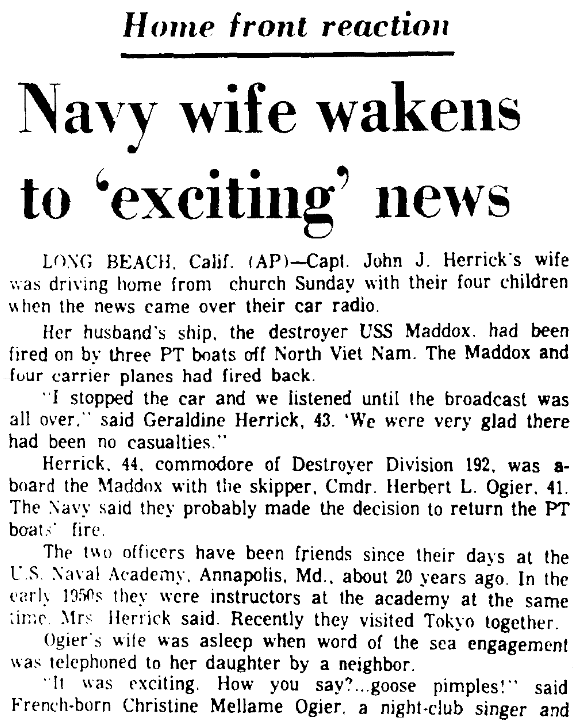
Here is a transcription of this article:
Home Front Reaction
Navy Wife Wakens to ‘Exciting’ News
LONG BEACH, Calif. (AP) – Capt. John J. Herrick’s wife was driving home from church Sunday with their four children when the news came over their car radio.
Her husband’s ship, the destroyer USS Maddox, had been fired on by three PT boats off North Viet Nam. The Maddox and four carrier planes had fired back.
“I stopped the car and we listened until the broadcast was all over,” said Geraldine Herrick, 43. “We were very glad there had been no casualties.”
Herrick, 44, commodore of Destroyer Division 192, was aboard the Maddox with the skipper, Cmdr. Herbert L. Ogier, 41. the Navy said they probably made the decision to return the PT boats’ fire.
The two officers have been friends since their days at the U.S. Naval Academy, Annapolis, Md., about 20 years ago. In the early 1950s they were instructors at the academy at the same time, Mrs. Herrick said. Recently they visited Tokyo together.
Ogier’s wife was asleep when word of the sea engagement was telephoned to her daughter by a neighbor.
“It was exciting. How you say?… goose pimples!” said French-born Christine Mellame Ogier, a nightclub singer and mother of three Ogier children.
The neighbor who telephoned was the wife of the executive officer of the Maddox, Lt. Cmdr. Dempster Jackson, 33. Marilyn Jackson had heard the news in a telephone call from the wife of a captain on another ship.
Thus word of the battle spread swiftly among the little colony of Navy wives in this, the destroyer’s home port.
Mrs. Jackson said: “All I cared about was that nobody was hurt.”
The Jacksons have four children – David, 8; Dennis, 7; Riley, 4; and Demi, 2½, a daughter.
Since Herrick sailed March 15, his wife said, four birthdays have occurred – his own, his wife’s and those of Dennis, 10, and daughter Maureen, 6.
“We expect him back in the fall, so we’ll have a big party then,” Mrs. Herrick added. Their other children are John Jr., 15, and Patrick, 13. The family lives in nearby Garden Grove.
Herrick was born in Warren, Minn., and attended Superior, Wis., State College before entering the Naval Academy. His mother is Lillian M. Herrick, a widow, of South Minneapolis, Minn. His brother, U.S. Army Gen. Curtis J. Herrick, is stationed in Ankara, Turkey.
Ogier was stationed in San Francisco before moving to Long Beach a year ago. He met his wife while he was stationed on a destroyer at Nice, France, 12 years ago. The couple has three children, Danielle, 11, Gerard, 10, and Richard, 9.
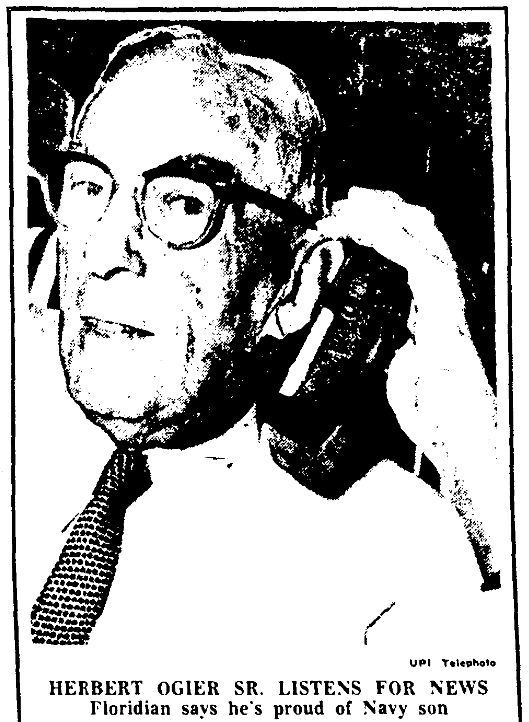
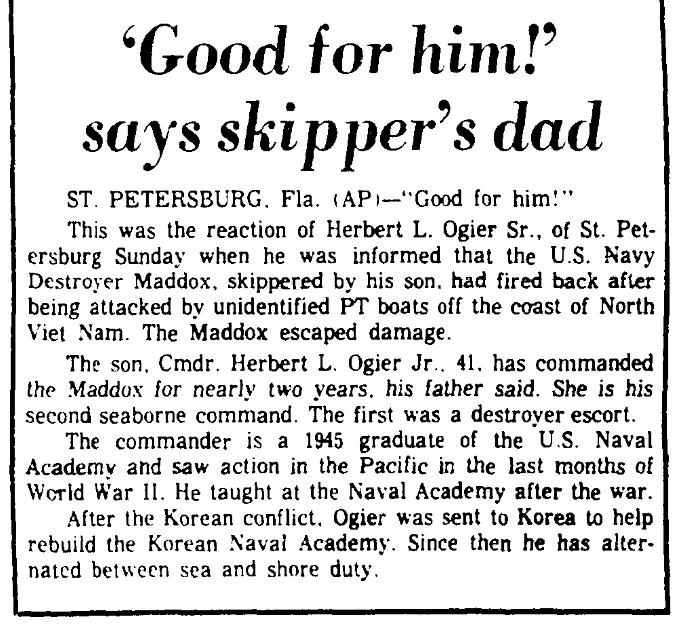
Here is a transcription of this article:
‘Good for Him!’ Says Skipper’s Dad
ST. PETERSBURG, Fla. (AP) – “Good for him!”
This was the reaction of Herbert L. Ogier Sr., of St. Petersburg, Sunday when he was informed that the U.S. Navy Destroyer Maddox, skippered by his son, had fired back after being attacked by unidentified PT boats off the coast of North Viet Nam. The Maddox escaped damage.
The son, Cmdr. Herbert L. Ogier Jr., 41, has commanded the Maddox for nearly two years, his father said. She is his second seaborne command. The first was a destroyer-escort.
The commander is a 1945 graduate of the U.S. Naval Academy and saw action in the Pacific in the last months of World War II. He taught at the Naval Academy after the war.
After the Korean conflict, Ogier was sent to Korea to help rebuild the Korean Naval Academy. Since then he has alternated between sea and shore duty.
Note: An online collection of newspapers, such as GenealogyBank’s Historical Newspaper Archives, is not only a great way to learn about the lives of your ancestors – the old newspaper articles also help you understand American history and the times your ancestors lived in, and the news they talked about and read in their local papers – as well as more recent events. Did any of your family serve in the Vietnam War? Please share your stories with us in the comments section.
Related Articles:
